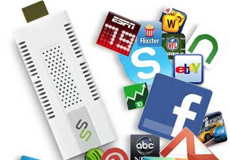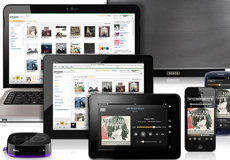By
Rob ScottDecember 19, 2012
Despite panicked reports regarding recent changes to Instagram’s terms of service, The Verge notes that the Facebook-owned photo-sharing service always had an expansive license to use and copy images, not unlike the agreements of other Web services that store user data. There has been an uproar to the following sentence, released earlier this week: “You agree that a business may pay Instagram to display your photos in connection with paid or sponsored content or promotions without any compensation to you.” Continue reading Instagram Users and Privacy Advocates Riled by New Terms of Service
By
Rob ScottDecember 19, 2012
By
Rob ScottDecember 19, 2012
YouTube has released a new basic iOS camera app that uploads automatically and makes sharing to social networks as easy as pushing just one button. Simply called Capture, it “comes with a few key features that make it superior to the default iOS camera app: It offers image stabilization and color correction, and users can trim clips and even add a YouTube-approved soundtrack,” reports GigaOM. Continue reading Google Aims to Replace iPhone Camera App with YouTube Capture
By
Rob ScottDecember 18, 2012
Huawei may possibly launch its long-awaited Windows Phone 8 handsets during CES in January. There is also speculation that the company will debut a 5-inch smartphone/tablet hybrid featuring a 1080p screen. “Huawei was one of the hardware partners listed by Microsoft when it revealed its new operating system in June, however despite a few leaks, the premier device from the Chinese manufacturer hasn’t officially appeared yet,” reports Digital Trends. “This could all change at CES, and Huawei could spearhead the second wave of phones running Windows Phone 8 with two new devices.” Continue reading CES 2013: Windows Phone 8 Devices and Hybrid from Huawei
By
Rob ScottDecember 18, 2012
Will the flexible smartphone screen change the face of mobile phone design in 2013 and mark the biggest change since the introduction of the touchscreen? Rumors suggest manufacturing rivals Samsung and LG are working on it. Speculation regarding flexible display development dates back to 2002, and in the last six years we’ve seen some interesting prototypes and low volume products at CES featuring E-ink and Electronic Paper Display technologies. To address slow response times (especially with video) and challenges with handling color, flexible OLED displays emerged. Continue reading CES 2013: Samsung and LG to Debut Flexible Smartphone Screens?
By
Rob ScottDecember 18, 2012
By
Rob ScottDecember 17, 2012
Facebook will offer improvements to its privacy settings by the end of the year to allow users to change and understand their privacy settings without going to a remote privacy settings page.
The social network will provide a dropdown box on “almost every page,” reports The Atlantic. Facebook will also include messages alongside posts to help people understand who can see the specific status update or picture.
Changes to the privacy settings are intended to help people understand who can see content, and to help users target and remove inappropriate or unwanted content.
The changes will not affect Facebook’s data sharing, and Facebook will continue to leverage user data to build targeted advertising.
While The Atlantic classifies the changes as mostly “cosmetic,” it still says they are important because simplifying privacy control could help Facebook gain user trust.
By
Rob ScottDecember 17, 2012
Morgan Stanley’s Katy Huberty issued findings this week regarding the much anticipated and perhaps never-to-be-realized “iTV.” Huberty surveyed 1,568 heads of households in the U.S., asking about smart TV habits. According to her results, 18 percent of those surveyed own smart TVs and 11 percent said they would be “extremely interested” in buying an Apple-branded TV. That percentage translates to 13 million units in the U.S. alone.
Those who already own Apple products were four times more interested in buying an iTV than those without. Perhaps most notable: “46 percent of respondents were willing to pay over $1,000 for an iTV and 10 percent were willing to pay over $2,000. On average, respondents were willing to pony up $1,060, a 20 percent premium over the the average $884 they paid for their current TV set.”
“Bottom line: iTV represents a $13 billion opportunity that could add $4.50 to Apple’s EPS,” suggests Fortune.
Huberty notes three potential “go-to market” strategies: 1) Apple becoming a virtual cable service provider; 2) Apple partnering with pay TV carriers and replacing their set-top box; or 3) Apple bundling its TV with its own digital media receiver.
“Because Apple’s biggest media-device successes (iPod, iPhone, iPad) have been end-to-end solutions — including hardware, operating system and the packaging and distribution of content — Huberty favors the third option,” notes the article.
By
Rob ScottDecember 17, 2012
Most consumers who watch television programs or movies on their wireless devices are not actually doing so while on-the-go, suggests a new report from the Interactive Advertising Bureau. The IAB report found that 63 percent of viewing takes place at home, while 36 percent takes place in a room that already has an existing device available to watch the content.
The report notes that two-thirds of respondents watch more than one hour of video a week on their smartphones or tablets. However, 85 percent of it is consumed in short bites of less than 10 minutes, according to VentureBeat.
“We need to see mobile as a primary screen for on-demand consumption, not as an afterthought,” says David Levin, president of digital agency 360i.
The report also points out that entertainment content is the most consumed, with music in the lead, followed by movie trailers, tutorials and funny short video clips. Perhaps most interesting to advertisers, the IAB study learned that 53 percent of respondents indicated they’re okay with mobile video advertising and 48 percent said the ads should relate to the video content being watched.
By
Rob ScottDecember 17, 2012
After two months of testing, Facebook Gifts is rolling out publicly to U.S. users. TechCrunch predicts that Facebook could earn between $127.5 million and $1.02 billion per year with the social commerce product.
 “It lets people choose a friend, often someone who’s birthday or wedding it is, and give them a real-life gift or gift card,” explains the post. “At first it only allowed a few users to access the beta, but then let the service grow organically so anyone who received a Gift gained the ability to give them. It dropped another couple tens of millions of users into Gifts in late November, and now is finally publicly available so anyone in the U.S. can give to other people stateside.”
“It lets people choose a friend, often someone who’s birthday or wedding it is, and give them a real-life gift or gift card,” explains the post. “At first it only allowed a few users to access the beta, but then let the service grow organically so anyone who received a Gift gained the ability to give them. It dropped another couple tens of millions of users into Gifts in late November, and now is finally publicly available so anyone in the U.S. can give to other people stateside.”
Since the social network currently touts roughly 170 million U.S. users, the earnings potential is massive. TechCrunch maps out this potential based on number of users and an assumed average gift amount, and speculates that Gifts could account for 3 to 24 percent of the social network’s annual revenue.
“Basically, Gifts will complement Facebook’s advertising and gaming revenue but won’t replace them,” suggests the post. “If it made $510 million a year, that would be $3 per year in additional average revenue per user in the U.S. That would nearly double the U.S. ARPU from $3.40 to $6.40.”
Of course, if successful, these numbers could increase dramatically with an international release.
By
Rob ScottDecember 17, 2012
It has taken an act of Congress, but the volume of television commercials will finally be turned down. The FCC has been fielding complaints from TV viewers since the 1960s and now the government has taken action with a law that went into effect last week.
“Representative Anna Eshoo (D-California) introduced the Commercial Advertisement Loudness Mitigation Act (CALM), which passed both the House and the Senate — where the vote was unanimous — in 2010,” reports TIME. “President Obama signed it on December 15, 2010.”
The law requires that the commercials be no louder than the broadcasts that accompany them. It has taken two years to implement, since stations and cable operators had to upgrade their equipment.
“Surprisingly, advertisers didn’t put up much of a fight over the legislation, likely realizing how annoying their ads had become to basically everybody who owns a television,” notes the article. “It’s not clear whether turning the sound down on ads will actually hurt ad awareness, but with more of us simply fast-forwarding through commercials on our DVRs, it probably won’t help, either.”
By
Rob ScottDecember 17, 2012
We’ve been following this year’s legal battles of Aereo as major broadcast networks have sued the online TV startup over copyright infringement. Since the service streams TV signals of New York stations for a monthly fee without paying for the right to carry signals, Aereo has created an uproar in the television industry. Now Aereo has begun paying for content, after adding Bloomberg TV to its program lineup.
 “We believe that our members will see deep value adding in Bloomberg Television as their ‘go-to’ source for financial news,” said Aereo founder and CEO Chet Kanojia in a written statement. The service also plans to announce expansion to 15 new cities early next year. Kanojia recently said that Aereo is pursuing additional content deals.
“We believe that our members will see deep value adding in Bloomberg Television as their ‘go-to’ source for financial news,” said Aereo founder and CEO Chet Kanojia in a written statement. The service also plans to announce expansion to 15 new cities early next year. Kanojia recently said that Aereo is pursuing additional content deals.
“Meanwhile, Aereo and major broadcasters are awaiting a critical decision from an appeals court in their legal battle,” notes the Wall Street Journal. “Last month broadcasters argued their appeal of a lower court’s decision in July denying the broadcasters’ request for a preliminary injunction shutting down Aereo’s service.”
The legal battle could take years to be resolved. “Without a preliminary injunction, Aereo has time to expand and streaming competitors also have a chance to emerge,” notes WSJ.
By
Rob ScottDecember 17, 2012
FAVI Entertainment recently announced it is shipping its plug-and-play SmartStick HDTV enhancer, which it claims is “your Smart TV, Home Theater and PC all rolled into one.”
“Like Roku’s Streaming Stick, it’s a media player that’s been squeezed into a dongle-sized form-factor, running Android 4.1 and packing apps like Netflix along with the Plex media server, a full Web browser and DNLA,” reports Engadget.
 The SmartStick streams media through the television’s HDMI port and connects to additional devices wirelessly. “You can even add a $40 wireless keyboard to avoid the usual finger calisthenics,” notes the post.
The SmartStick streams media through the television’s HDMI port and connects to additional devices wirelessly. “You can even add a $40 wireless keyboard to avoid the usual finger calisthenics,” notes the post.
According to the press release, the device offers apps such as Netflix, HBO Go, Epix, Pandora, Spotify, YouTube, Pinterest, Facebook, Twitter and others. The 4GB device is priced at $50, while an 8GB version costs $80.
“Included with the SmartStick is the Plex app where you can wirelessly deliver videos, documents, music, images, movies directly to your SmartStick enabled television making your TV a hub of entertainment — no subscription needed,” according to the release.
By
Rob ScottDecember 17, 2012
Amazon’s cloud-based music storage and streaming service is now available on Roku and Samsung’s Smart TVs, allowing users to play digital music on a single device. The app “finally gives Roku a good response to Apple TV’s iTunes Match,” notes CNET. Months ago Roku announced that the Amazon Cloud Player was “coming soon.”
 Like its competitor iTunes Match, Amazon Cloud Player charges $25 per year to store up to 250,000 songs. It also includes a feature that automatically identifies music files and upgrades the quality using a 256 Kbps file from the Amazon catalog. “That’s a ton of digital music, although the competing Google Play Music allows you to store up to 20,000 tracks for free and is available on Google TV devices,” explains the post.
Like its competitor iTunes Match, Amazon Cloud Player charges $25 per year to store up to 250,000 songs. It also includes a feature that automatically identifies music files and upgrades the quality using a 256 Kbps file from the Amazon catalog. “That’s a ton of digital music, although the competing Google Play Music allows you to store up to 20,000 tracks for free and is available on Google TV devices,” explains the post.
The release was announced the same day that Amazon added its Amazon Instant Video app for the iPhone and iPod touch.
According to a related post from CNET, the Instant Video streaming app “allows for access to over 140,000 movies and television shows that can be downloaded for purchase or rental.”
Amazon offers access to its streaming library across devices including the iPad, Kindle Fire HD, PlayStation 3, PCs and Macs. The app is only available to customers who pay for the company’s $79-a-year Prime membership.



